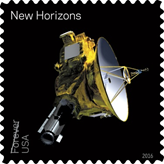

New Horizons and Pluto
The Pluto—Explored! souvenir sheet contains two stamp designs. One shows an artist’s rendering of the New Horizons spacecraft. The other shows the spacecraft’s striking image of Pluto taken near its closest approach. The view — which is color-enhanced to highlight surface texture and composition — is a composite of four images from New Horizons’ Long Range Reconnaissance Imager (LORRI), combined with color data from the imaging instrument, Ralph. It clearly reveals the now-famous, heart-shaped feature that measures about 1,000 miles across at its widest point.
The Pluto flyby completes a historic, half-century era of solar system reconnaissance by the United States. After NASA probed every planet out to Neptune between 1962 and 1989, it took another quarter century to reach Pluto. The United States has been the first nation to explore each of the planets.
The New Horizons mission to Pluto and the vast region beyond Neptune called the Kuiper Belt is one of the great explorations of history.
Views of Our Planets Forever Stamps
The planets of our solar system have been viewed with increasing clarity during the modern era of space exploration thanks to the distant voyages of unmanned spacecraft and the development of ever-more powerful telescopes. With this pane of stamps, the U.S. Postal Service showcases some of the more visually compelling full-disk images of the planets obtained during this era. Antonio Alcalá was the project's art director and designer.

Mercury
The image of Mercury seen on the stamp pane is one that NASA’s MESSENGER spacecraft captured shortly after entering the planet’s orbit in March 2011. This color image highlights differences—chemical, mineralogical and physical—between the rocks on the planet’s surface. In actuality, Mercury is gray in appearance. MESSENGER circled Mercury thousands of times before completing its mission in April 2015.
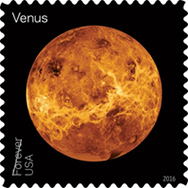
Venus
Venus, the planet closest to Earth, has been explored many times since NASA’s Mariner 2 completed a flyby in 1962. Most of its surface, however, remained elusive until the 1990s, when NASA’s Magellan spacecraft penetrated the planet’s thick atmosphere and mapped most of the planet’s features using a radar microwave energy sensor. The false color image of Venus shown on the stamp pane was created in 1991 mainly from surface data generated by the Magellan sensor. In actuality, the cloud cover of the planet gives it an off-white appearance.
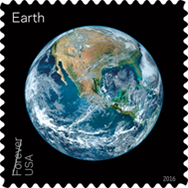
Earth
One of the most detailed views we have of Earth is also featured on the stamp pane. This composite image of Earth was created using data from the imaging radiometer instrument on the NOAA/NASA Suomi NPP (National Polar-orbiting Partnership) satellite. It orbits the Earth about 14 times a day. The image was created from four orbits of data taken over a six-hour period on Jan. 4, 2012. This image is just one of the many different kinds of observations provided by the instruments on Suomi NPP. Suomi NPP provides essential weather observation data to NOAA’s National Weather Service and contributes to NASA’s study of Earth’s climate.
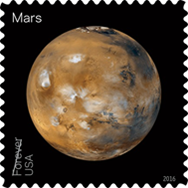
Mars
Also on the stamp pane is a computer-generated map of Mars that combines 24 images obtained during a single day in 1999 by NASA’s Mars Global Surveyor Mars Orbiter Camera. The map gives a snapshot of the planet’s weather patterns on that day. The Mars Orbiter Camera operated between 1997 and 2006 and returned some 240,000 images.
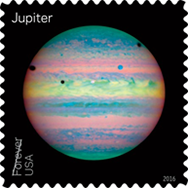
Jupiter
NASA’s Hubble Space Telescope has
obtained many beautiful images of Jupiter, including the unusual one that is featured on the stamp pane. Hubble’s Near Infrared Camera and Multi-Object Spectrometer captured this view in 2004 during a rare alignment of three of the planet’s moons: Io, Ganymede and Callisto. The three dark circles in the image are the shadows cast by those moons. Viewing Jupiter in the near infrared makes the planet appear to be pastel colored while its clouds show different colors depending on their altitude.
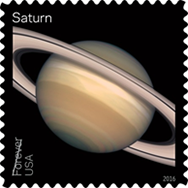
Saturn
With its Wide Field Planetary Camera-2, Hubble also captured a beautiful sequence of images of Saturn from 1996 to 2000. One taken in 1998 is shown on the stamp pane. Astronomers used these photographs to investigate the composition of Saturn’s rings and to learn more about how they were formed. The rings are made up largely of reflective particles of water ice (along with some rocks and dust), which range in size from tiny grains to large boulders. Beginning in 2004, NASA’s Cassini mission followed up these investigations and at one point even flew through one of the gaps in Saturn's rings.

Uranus
In 2003, Hubble’s Space Telescope Imaging Spectrograph and the Advanced Camera for Surveys obtained the false color image of Uranus shown on the stamp pane. It reveals faint bands similar to those found on Jupiter and Saturn. Colors in the bands give scientists a method of measuring the altitudes of the planet’s clouds. The true color of Uranus has been described as a dull blue or as blue-green.

Neptune
Finally, the image of Neptune on the stamp pane was taken in 1989 from a camera aboard NASA’s Voyager 2, when it became the first spacecraft to observe the planet. Its blue color results from the methane in Neptune's atmosphere. Voyager 2 discovered the “Great Dark Spot” (the light area in the center of this image), a storm system surrounded by clouds of frozen methane that have since disappeared.
When reproducing the stamp images for media use only, please provide the copyright sign (the “c” inside the circle) and 2016 USPS.
- Earth – Credit line: NASA
- Jupiter – Credit line: NASA, ESA and E. Karkoschka (Arizona Board of Regents, University of Arizona)
- Mars – Credit line: NASA/JPL-Caltech/MSSS
- Mercury – Credit line: NASA/The Johns Hopkins University Applied Physics Laboratory/Carnegie Institution of Washington
- Neptune – Credit line: NASA/JPL-Caltech
- Saturn – Credit line: NASA and The Hubble Heritage Team (STScI/AURA)
- Uranus – Credit line: NASA, ESA and E. Karkoschka (Arizona Board of Regents, University of Arizona)
- Venus – Credit line: NASA/JPL-Caltech
# # #
Please Note:
For broadcast quality video and audio, photo stills and other media resources, visit the USPS Newsroom at about.usps.com/news/welcome.htm.
For reporters interested in speaking with a regional Postal Service public relations professional, please go to about.usps.com/news/media-contacts/usps-local-media-contacts.pdf.
Follow us on twitter.com/USPS and like us at facebook.com/USPS. For more information about the Postal Service, go to usps.com and usps.com/postalfacts.
